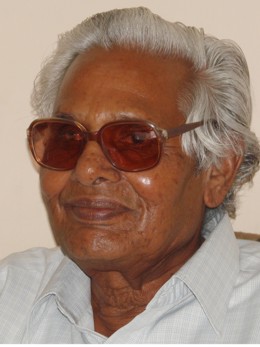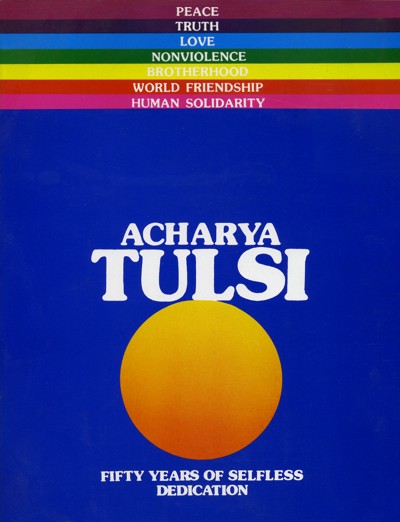The Anuvrat Movement has been engaged in the noble task of uplifting human life and revitalizing the rapidly crumbling moral and spiritual values among the people of our country irrespective of caste, creed and colour for the last three and a half decades.
Launched on March 1, 1949 by Acharya Shree Tulsi - the head of a Jain Sect and a leading visionary of India - the Movement has since grown steadily in size and stature. Though it does not lay claim to any spectacular success or achievement, there is no gainsaying the fact that its universal appeal for self-awakening has created a great impact on the outlook and behaviour of many people. It was hailed and patronized by eminent people like the late Dr Rajendra Prasad, C. Rajgopalachari, Pt. Jawaharlal Nehru, Dr S. Radhakrishnan and Jai Prakash Narayan. It has been striving to infuse with new life people degenerating fast into what T. S. Eliot aptly calls 'automations or living shadows inhabiting the great wasteland'.
While many western celebrities like Bertrand Russell and Martin Luther King were organizing huge peace rallies exhorting the people to raise their voice against the senseless genocide caused by the nuclear holocaust in Hiroshima and Nagasaki, by a strange coincidence, as it were, a relatively unknown religious preceptor of the East heading a Jain sect, seated far away in a remote town of the Thar desert of Rajasthan, was engaged in an identical mission, though in a small way, of rousing the masses against violence and moral torpor. He heard the inner call that commanded him to throw off the yoke of sectarian dogmatism and launched a crusade against caste, untouchability, subjection of women and religious intolerance. His response to the call resulted in the birth of the Anuvrat Movement. It was in this very way that Simon and Andrew responded when Jesus walking by the sea of Galilee called to them. The only difference was that the call Acharya Tulsi heard came from within, not unlike the one Saint Joan had heard centuries before in France. But unlike as in her case the inner voice directed the Acharya to launch a movement for liberating the individual from a bigoted sectarian outlook, fanaticism and an unethical approach, thereby automatically ensuring the emancipation of mankind.
The root of the malady lies in the individual. The Acharya realized that society cannot be purged without an inner transformation of man. Instinctively motivated by the maxim
In small proportions we just beauties see; And in short measures, life may perfect be.
Acharya Tulsi began his mission by carefully drawing up a code of conduct for all individuals in society. This code consisted of atomic or small vows {anuvrats). He launched what came to be known as the Anuvrat Movement urging the individuals to pledge themselves willingly to observe the anuvrats. The Movement embodied a vision of a harmonious society free from exploitation and conflict. There is a striking similarity between his vision and that of Tagore's heaven of freedom as pictured by him in his immortal work Gitanjali.
The most important thing about the Movement is that it strives after the middle path steering clear of the two extremes of absolute asceticism (mahavrats) and unbridled materialism resulting in moral torpor and acedia. The Anuvrat Movement aims at ushering in an era of self-awakening - the antithesis of the Atomic Age.
The Acharya carried his message far and wide covering thousands of miles on foot, enjoining on the people the discipline of anuvrats.
The voice of the Movement has by now permeated the masses focussing their attention on the importance of self-restraint. The phenomenal rise in incidents of communal clashes and racial riots in the fast-growing multicultural societies mushrooming all over the world giving rise to frenzied massacres like the ones the world watched helplessly in Sri Lanka, Lebanon and South Africa makes it imperative for everyone to carry the Movement across the seas to ensure amity and reconciliation between differing groups and cultures.
Acharya Shree realized in the wake of his experiment of enjoining the discipline of anuvrats on the individuals that a radical attitudinal change in man was not possible merely through the advocacy of the anuvrat code of conduct. It must be accompanied by another effective tool that can gradually induce him to introspect. Yuvacharya Mahapragya came up with a bright idea of a unique technique of meditation called Preksha Dhyan as a means to bring about a mass psychological transformation. Acharya Shree added Preksha Meditation to his programme of reconstruction of moral and spiritual values. Fortified with this potent means of an attitudinal change in man, the Anuvrat Movement has added a new and important dimension. A follower of the anuvrat code has to practise Preksha Meditation every day, which inclines him naturally to imbibe the anuvrat discipline. It ultimately becomes an integral part of his character.
The ideational phase of the Movement is over. It is time we gave it a programmatic and practical shape Let us transform the Movement into a fitting instrument of constructive activities - a veritable laboratory for testing our belief in the anuvrat philosophy. Acharya Shree has launched a new scheme of Jivan Vigyan for educating youngsters in the doctrine of anuvrats so that they may grow up as disciplined, broad-minded and responsible citizens free from the narrow prejudices of caste, colour, creed and sect. He pins his hope of transforming mankind into one family on this young generation. As head of a religious sect he has set the pace for other religious leaders. If they take their cue from him, the world that lies steeped in communal and ethnic violence today is certain to awake into a 'heaven of freedom'.
In conclusion, we might remember Neil Armstrong's spontaneous utterance on first stepping on the soil of the moon, 'One small step for a man but one giant leap for mankind.' Who knows Acharya Shree's small step (anuvrats or atomic vows) may eventually turn out to be a giant leap for mankind?
It is not one's money but one's heart that makes for prosperity. Likewise, it is despair and not poverty that makes for indigence.
|
 Dr. Sohan Lal Gandhi
Dr. Sohan Lal Gandhi
